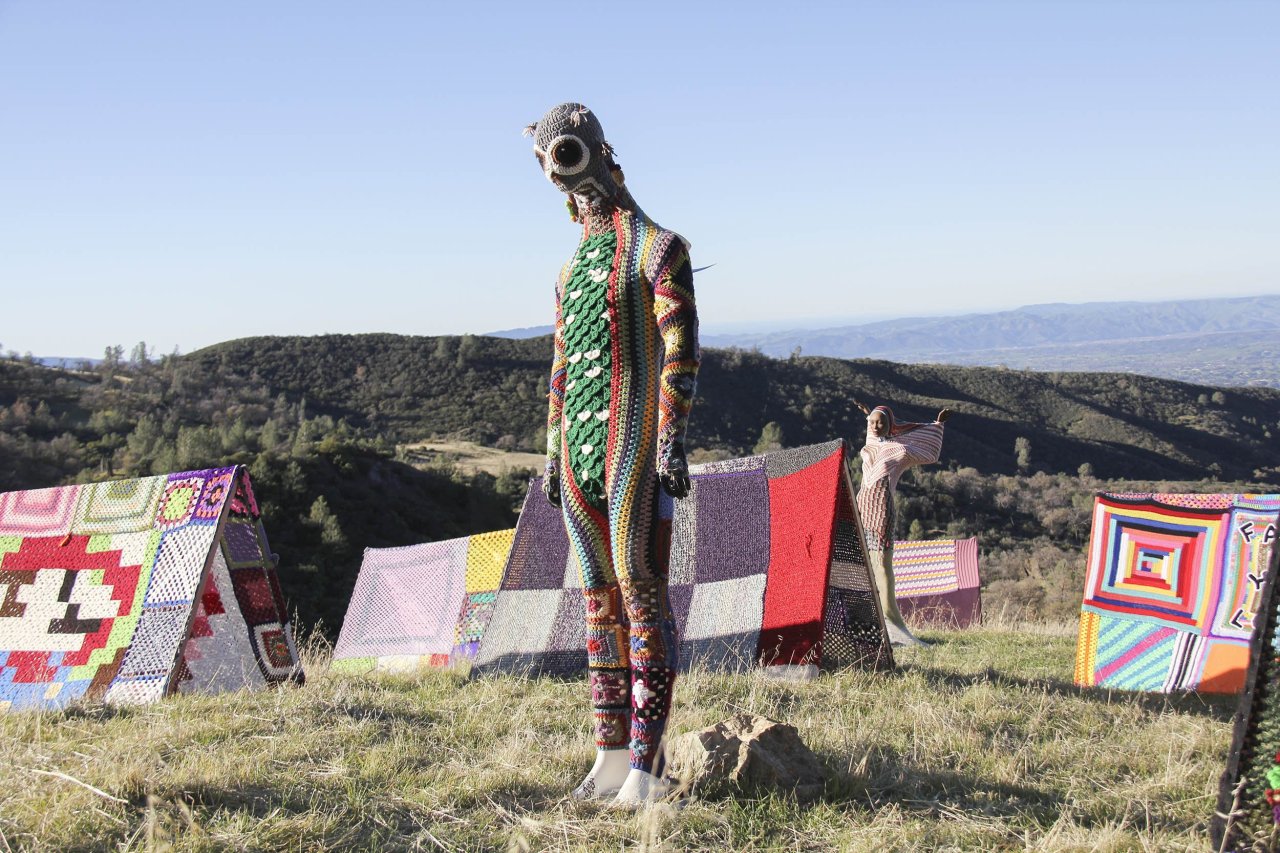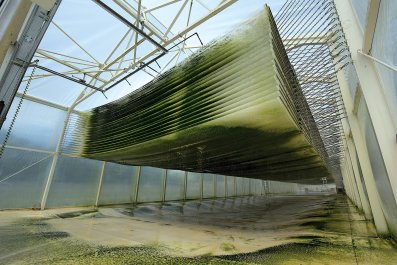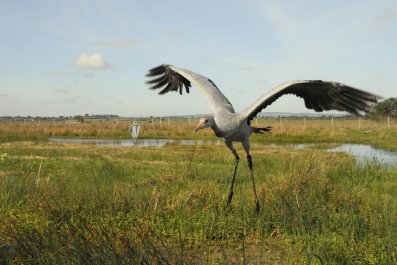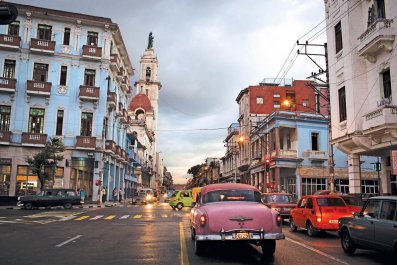Relax. They didn't come from Mars or some distant, undiscovered galaxy. The 10 aliens (and their 24 tents) that appeared in the backcountry of Santa Barbara, California, in late January were conceived in the backyard of a hedge-fund manager turned yarn bomber.
"Yarn bombing," for those out of the loop, is a public and oft-times guerrilla art form in which all kinds of objects, from parking meters to hulking vehicles, get covered in brightly covered yarn. Some may remember the Mexico City bus stitched over in 2008 by Magda Sayeg, often called the "mother of yarn bombing." Typically, yarn bombers ply their craft in urban areas for maximum exposure.
But Steve Duneier, a 47-year-old Brooklyn, New York, native, is bringing it to the wild. "My goal is to draw more people into the wilderness, which I do by detonating massive, colorful yarn bombs in nature," says Duneier. (For the record, this project can't really be termed guerrilla, since he got a permit from the Los Padres National Forest folks.)
If the wording sounds a tad violent, rest assured: Duneier's public installations induce a calm, even meditative experience. His latest, Alien Campsite, sits on a meadow carpeted in lacey wild grasses with views extending to the Santa Ynez Mountains and the distant Pacific. It didn't hurt that the day I viewed it the sky was boundless blue and temperatures were in the '70s.
Indeed "bombing" is the last word I'd associate with the peaceful scene featuring Duneier sitting cross-legged, clad in his trademark cowboy hat, watching clumps of visitors strolling amid the works. One of them, Jeff Wing, a 55-year-old writer, says it's not at all what he expected. "It's more striking than I really pictured. Even though the colors are jumping, it seems almost like an organic extension of the landscape," Wing says.
This was the second of Duneier's yarn bombs for Emily Baum, a 20-year-old Santa Barbaran studying environmental science and animal ethics at New York University. "I was at the one he did last year at Lizard's Mouth [a boulder-strewn field in the foothills overlooking Santa Barbara]. It was really cool to see how the whole space was transformed. I mean, I love it. This one is ka-razy.… I've never been to this spot before, and it's beautiful; so it got us up and out, which is supercool."
With no publicist, Duneier relies on word of mouth and social media to get people to his events. Still, it's the chance encounters with his creations that most excite him. "My favorite part of the whole process is when I hear people walking up a trail, bantering back and forth and they turn a corner and their conversations cease and I hear these gasps and the 'Holy cow!' That's what I'm looking for—to really surprise people in a good way."
Duneier's transformation from high finance to high-altitude art can be traced back to a series of New Year's resolutions he concocted in 2012. While most individuals focus on losing weight or organizing their offices, Duneier took the concept to a new level by committing to a list of "Giving" and "Learning" resolutions. Among the 12 items on his "Giving" list: building homes for the Apaches of Arizona and donating bone marrow. But while compiling his "Learning" list—among them mindfulness, veganism and unicycling up a mountain (which he did)—his wife suggested knitting and proceeded to teach him the basics. Duneier hated it. "It was supposed to be this Zen-like thing that I heard people describe, but it was aggravating and frustrating for me right up until I stopped doing it," he says.
He botched his first knitting project, a scarf. Somehow though, he powered through stitch after stitch to launch his first yarn bomb—on a giant Eucalyptus tree two and a half miles up a popular hiking trail. Unfortunately the date he'd set for the event didn't leave him enough time to complete the 400 square feet of yarn he needed, so he sought help from the knitting community.
Some 12 people from around the country ended up contributing, not including the three friends Duneier enlisted to lug the yarn and his rented ladder up the mountain.
The multi-hued trunk wowed hikers as they caught sight of the solitary tree dressed in every imaginable color. The yarn bomb became an Internet sensation, with the knitting community sharing stories and posting photos of the Cold Spring Tree.
The installation was up for nine days, then "defused," and shipped off to Warm Up America, a North Carolina-based charity that converted the knitted pieces into blankets and scarves for the needy.
At the time, Duneier thought his foray into yarn bombing was over, but six months later, Marcy Maltese, one of the contributors to the tree project, asked him to crochet some pieces for her project to convert giant cement slabs into Rubik's cubes for Comic-Con in San Diego. So Duneier did what anyone with a degree in finance and economics would do; he taught himself to crochet, by watching one of Maltese's YouTube videos. "Almost instantly I enjoyed it. So I just start going like mad on airplanes, since I was traveling for business at the time."
Other projects followed, like his 2013 Saddle Rock yarn bomb of a massive boulder. Last February he suspended a 16-foot Starfish made of reflective yarn over a series of small waterfalls. The undertaking, which involved some risky rock climbing, ended up getting torn down by vandals.
But it was his Lizard's Mouth yarn bomb last June that got him local TV coverage and solidified his commitment to the art form. And though he contributed a brightly colored American flag, the bulk of the work featured contributions from 388 knitters from 36 countries and every state—all critical in transforming 18 sandstone boulders to surreal blobs of color in the otherwise subdued landscape. "When you step back, you see a massive installation, but when you zero in on it, you've got these pieces that people send in that are works of art on their own."
Having grown up in South Florida, Duneier often cites Christo's wrapping of the Biscayne Bay Islands as a big inspiration, but Chuck Close, the photorealist known for his larger-than-life portraits, is a bigger influence. "Close does these paintings where each square is like a little amoeba-shaped painting, very colorful, bright and odd-looking, but when you pull it back, there's a portrait. That is the way I see what I do with the yarn bombs"
For Alien Campsite, Duneier had even more contributors: 656 artists from 41 countries and all 50 states. The seven months of preparation involved not only assembling the hundreds of contributor pieces but also finding the mannequins and hack sawing and reconfiguring their body parts to achieve the look he desired. For example, to create Long Neck, Duneier removed the head, then fabricated an extended neck using chicken wire wrapped with fiberglass and duct tape. What emerges is an elegant-looking being with swirls of (relatively) muted colors that complement the red lipstick on her visage.
For The Sorceress, Duneier swapped out the left and right arms, and then positioned them so they faced behind her body to mimic wings. To that he added a dazzling rainbow-colored head covering juxtaposed with her wild-patterned "skin."
("I would love to wear anything that these aliens are wearing," Baum says.)
Duneier didn't want the figures "just standing there," so he added tents, which he fashioned out of long pieces of wood. "This idea of having tents and these odd creatures made of yarn in the middle of nowhere came together as the Alien Campsite."
The result may seem at first to be an odd pairing, but many visitors think it enhances the already captivating surroundings.
Not that there aren't detractors. "This is an affront to nature," wrote a commenter on the Santa Barbara city blog, Edhat. "This is all ego, and zero respect for wildlife," wrote another. "I cringe when I think of the little bits of nature that will be destroyed underfoot."
But Helen Tarbet, field ranger for the Los Padres National Forest, sees it differently. "It's like any other permit we do. We have to do an environmental impact study to make sure it's not disrupting anything and so when we do this environmental study, it goes to all the different specialists. And they all gave us their thumbs-up. There was nothing that this was disrupting. "
In fact, Duneier uses materials that make no impact on the environment. And unlike most other yarn bombers, who leave their work up indefinitely, Duneier has a self-imposed nine-day limit for his temporary shows. After that, he painstakingly disassembles everything to avoid leaving a trace.
With Alien Campsite, however, nature beat him to it. On the second night a violent wind storm damaged much of the work. "Unfortunately," says Duneier, "I was at the right place at the wrong time. But it's the process of converting a dream into reality that determines success or failure for me. The time between installation and tear-down is the bonus."


























